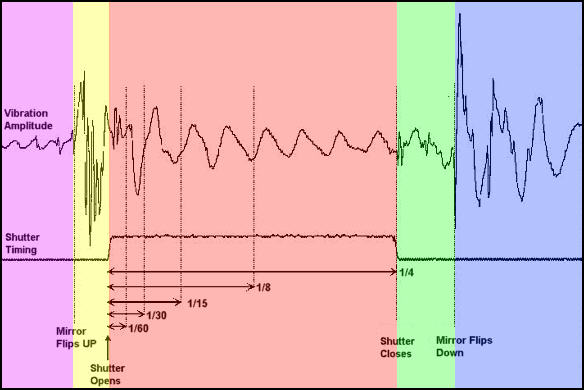
|
Mirror Lock-up [MLU]With the exception of a couple of very special cameras (which I will deal with later), every SLR has a mirror which must be moved out of the optical path before a photograph can be taken. When this mirror moves (and especially when it stops moving!), it causes vibrations to be set up. These vibrations move the camera (and attached lens) around and can lead to a loss of image sharpness. This is especially the case when using long telephoto lenses or when doing closeup (macro) photography. The loss of image shapness is worst at intermediate shutter speeds, say between 1/60 and 1/2 second. At very fast speeds the shutter is only open for a small part of a vibrational cycle, while at long shutter speeds the vibrations can die out, so only a small part of the total exposure is taken while the camera is shaking. Note that an flimsy tripod can make vibrations worse, but even the biggest, heaviest tripod can't eliminate vibrations completely.In general, for lenses of 300mm and over (and macro work), users should try to avoid using shutter speeds between 1/30 and 1/4 second for optimal sharpness. For "normal" work with lenses of 100mm or less, sharpness loss due to mirror induced vibrations does not seem to be an issue. The solution to this problem is Mirror Lock Up (MLU), where the SLR mirror can be locked in the "up" position, vibrations can be allowed to die out, then the shutter fired. Not many current SLRs have this function (the Nikon F4 and F5 do, as does the Canon EOS-1n), which is a pity. Some cameras do have what is called "mirror pre-fire" though. This is a mode in which the SLR mirror moves normally, but the camera delays the firing of the shutter by a couple of seconds, so the mirror induced vibrations have a chance to die out before the shutter fires. Most Canon EOS bodies have this function, for example. Nature photographers planning on using long telephoto or macro lenses might want to look for MLU (or mirror prefire) on any camera bodies they plan to purchase. If a body doen't have MLU and you must use speeds around 1/15 with a telephoto lens, tricks such as putting one tripod under the lens and a second tripod under the camera can help, as can laying a sandbag, beanbag or even a hand on the lens above the tripod support point. A few cameras have a fixed, semi-transparent mirror, rather than a conventional moving mirror. Obviously these cameras don't need MLU! The only current camera of this type is the Canon EOS-1n RS, though the Canon EOS RT can be readily found on the used market. The downside of these "fixed mirror" (pellicle) designs is that they cost about 2/3 stop of light at the film, and 1 1/3 stops in the viewfinder. The upside is that you can see through the viewfinder in real time. With a locked up mirror, the viewfinder is blacked out. The figure below shows a typical vibration plot which illustrates most of the points made above. I made the measurements based on the deflection of a laser beam reflected from a camera, and it is part of an article I wrote for George Lepp's "Natural Image" newsletter. 
You can see that the initial fast vibrations (yellow) caused by the mirror going up pretty much die out by the time the shutter opens (red). Then with shutter speeds faster than about 1/60s, the vibrations are relatively small in amplitude and the image is effectively "frozen". With longer shutter speeds the image may go through one or more high amplitude, lower frequency vibration cycles and that's what causes the image to blur. At longer shutter speeds (over 1/4s) only a small faction of the exposure takes place while the image is subject to vibrations which are large enough to blur it. Vibrations caused by the shutter closing (green) and the mirror flipping back down (blue) don't affect the image of course. Every camera is different and the degree of vibration depends on how well the camera is supported and how well the vibrations are damped and these are functions of the tripod, the head and how the camera is attached to the head, so the analysis here is just a typical example. However it does seem that shutter speeds between about 1/30s and 1/4s are most vibration prone with all cameras.
© Copyright Bob Atkins All Rights Reserved |
|